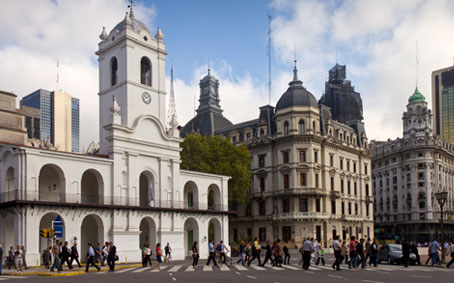


Receive this content
Argentina. Buenos aires
Our starting point is naturally Plaza de Mayo, where we observe the most conspicuous of Buenos Aires' Colonial buildings: the Cabildo, primitive town hall. We also admire the neoclassical Metropolitan Cathedral, and our Presidential Palace, known as the Pink House, with its peculiar asymmetrical façade. Finally, we trace the tracks of Monumentalism, visible in the Ministry of Economics building. Next, we walk across Avenida de Mayo, a tree-lined boulevard built in the late 19th century, when Paris was undisputedly the center of the world. Alongside the Avenue, many different-styled buildings were erected -Academicism, Borbonic, Italian, Neo-Baroque, Art-Nouveau and Art Deco, among other styles. Some of the buildings we'll be seeing in more details are, among others, La Prensa, nowadays the House of Culture; the Vera Palace; the traditional Hotel Castelar; and the monumental Barolo Palace, inspired on Dante's Divine Comedy. At the other end of the avenue lies the Congress, and the traditional El Molino tearoom. Next, we head for Puerto Madero, a cutting-edge urban renovation project initiated in 1991, located in the docks of a huge abandoned port district were recycled into upscale residential buildings, trendy restaurants and VIP nightclubs. On our way to Recoleta, we'll pass along the impressive Tribunales building, a patent example of the early 20th century Academicism style, built by French architect Norbert Maillard, the Colón Theater, one of the city's greatest attractions, and the Cervantes National Theater, a Renaissance building with Plateresque columns. Then, we'll visit Plaza San Martín, designed by French-Argentine landscape architect Charles Thays. Around the square lie some of the city's most conspicuous buildings: the former Palacio Paz, nowadays the Military Society, and the Kavanagh Building, South America's first skyscraper, among others. Once in Recoleta, we'll visit the namesake Cemetery, one of Buenos Aires' greatest attractions. Inaugurated in 1822, this true labyrinth of funeral monuments commissioned to some of the greatest artists of the last two centuries is the eternal home of the most conspicuous -and wealthy- figures in Argentine history, paradoxically including Eva Perón, who was a known enemy of the upper classes. Next to the Cemetery, we visit the Basílica de Nuestra Señora del Pilar, a Colonial church built in 1732 that is surprisingly well preserved. We then walk across Alvear Avenue, where we observe the sumptuous palaces built by the Argentine aristocracy to rival with Paris, such as the Ortiz Basualdo palace. After seeing the imposing Neoclassical mass of Buenos Aires Law School, on Figueroa Alcorta Avenue, we'll visit the peculiar Sanitation building, with its strange majolica façade, built in 1887. This strange French Renaissance palace was built entirely from detachable pieces.